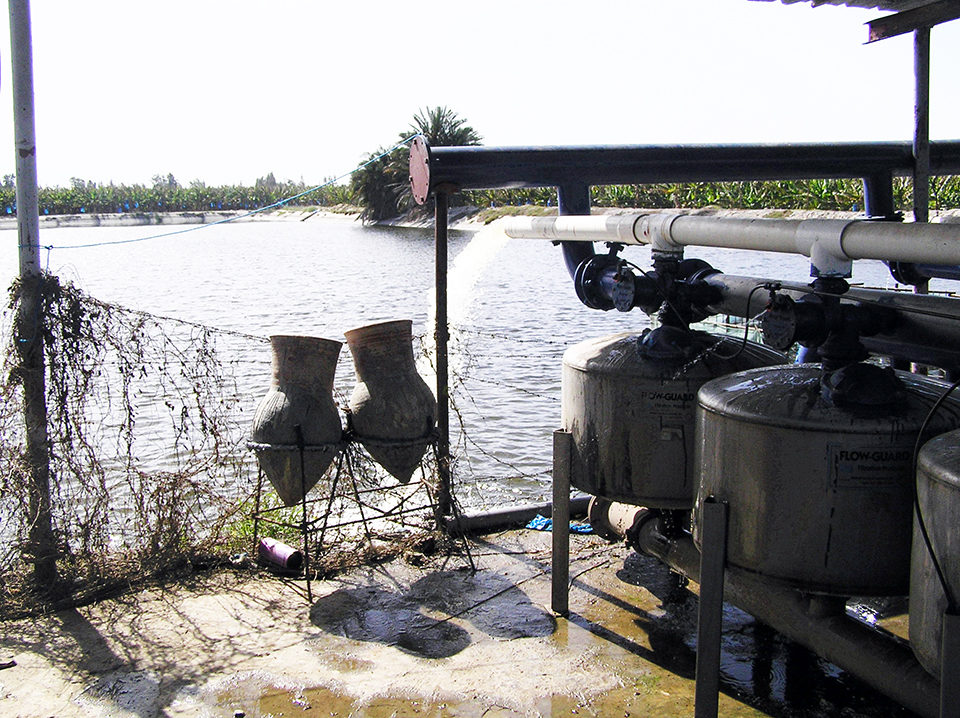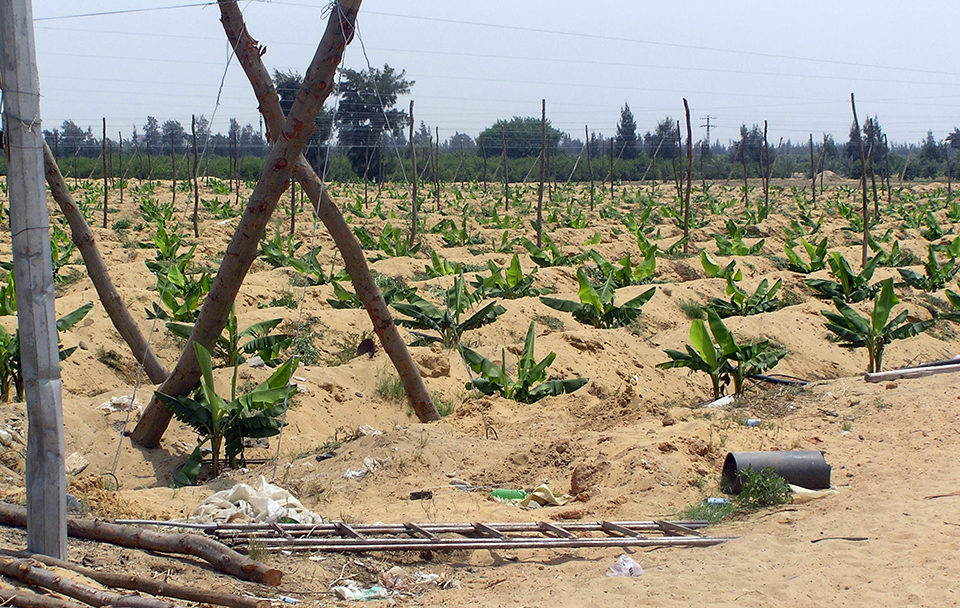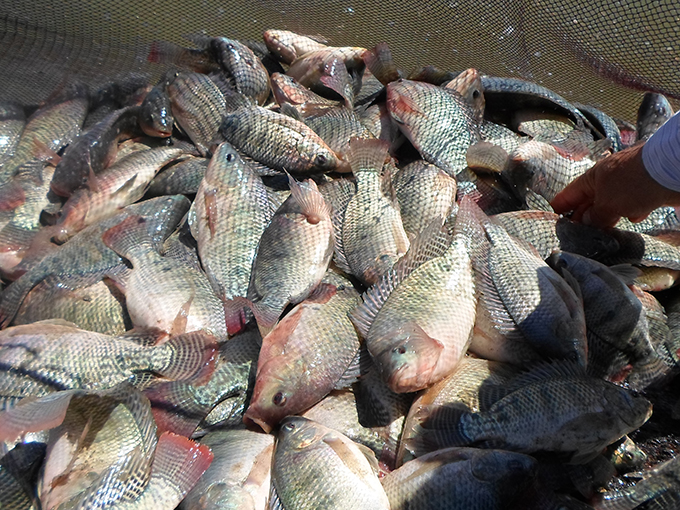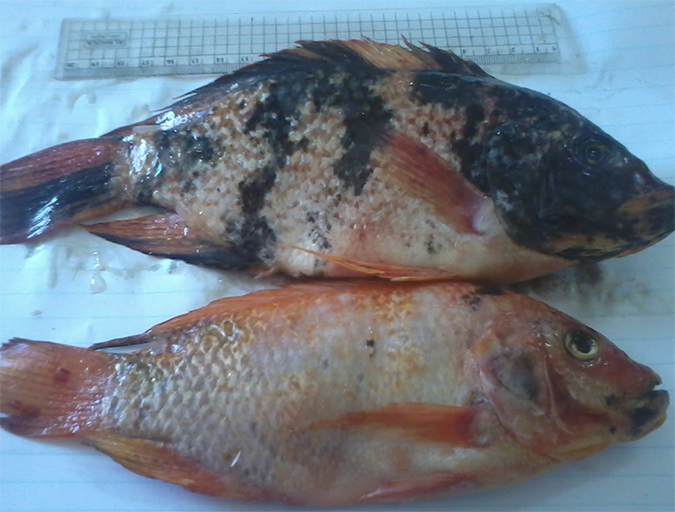Experiences with limited water resources in Egypt

With annual production of 705,000 mt in 2009, Egypt is by far the largest producer of farmed fish in Africa. Aquaculture provides 65 percent of the fish consumed in Egypt. Nile tilapia make up 55 percent of the farmed fish production, followed by mullet and various carp species.
Since Egypt’s government established the first carp farm in 1961, entrepreneurs of various kinds have responded to the growing interest in fish farming and demand for inputs. The sector saw modest growth until 1995, then production increased steeply.
The rediscovery of Nile tilapia (Oreochromis niloticus) as a species suitable for aquaculture, expansion of pond area and improved techniques resulted in higher pond productivity. The stocking of sex-reversed, all-male fingerlings and use of high-quality feeds and aeration also made the growth possible. Over 300 private tilapia hatcheries and 16 fish feed producers can now be found in Egypt.
Fish culture in ponds is one of the few possibilities to make productive use of areas with brackish or saline soil and water. Fish farm development in such areas was actively supported in Egypt, especially in the northern parts of the Nile delta. Hundreds of floating cages in various branches of the Nile also contributed to the production increase.
Although aquaculture is a major industry in Egypt, it must compete with other users for water resources.
Water use
The water of the river Nile is Egypt’s major renewable freshwater source. An agreement on Nile water extraction with countries located upstream guarantees Egypt a fixed minimum quantity of water, but most of this quantity is already used.
With 84 percent, agriculture is the largest freshwater user. Growing more food with less water would make more water available for other natural and human uses, now and in the future.
An extensive system of canals and pumping stations enables the water supply and drainage in the Nile delta area. Legislation dating from 1983 aimed at regulating the use of Nile water designates the water in irrigation canals for agriculture and domestic use. The farming of fish is not recognized by the Ministry of Water Resources and Irrigation as an agricultural activity, and farms producing market-size fish are legally excluded from using the water in the irrigation canals.
Integrated farms
About a dozen commercial farms have integrated aquaculture and agriculture. Such farms use semi-intensive or intensive fish production methods and fall in two categories.
The first category uses underground water sources and applies intensive fish production techniques involving concrete basins, aeration and high fish densities. The effluent resulting from partial water replacement is used to irrigate crops and fruit trees.
The second category consists of primarily agriculture farms that grow an additional fish crop in reservoirs that were built to store Nile water for irrigating crops and trees during periods when the local irrigation canal does not contain sufficient water.
Double use of water seems to make sense, especially in a country where freshwater resources are limited. But are farms that combine different production systems indeed benefitting from the integration of fish with crops or fruit trees?
Quantitative data on water use at Egyptian fish farms, especially integrated fish farms, are scarce. To obtain such data and assess the impacts of fish farming in integrated systems, the water use and crop and fish production of four farms were studied in 2010 by scientists of the WorldFish Center, an international research institute based in Abbassa, Egypt. This study was financed by the Netherlands Ministry of Economic Affairs, Agriculture and Innovation.

Research study
Four commercial farms based in the Sharkia, North Sinai and Behera Governorates were visited monthly between May and December 2010 by researchers who collected data on farm design, water use and farm production. Also, samples of the water source and the water in the ponds were analyzed in the WorldFish Center laboratory.
Two farms belonged to the first category. They used wells, intensive tilapia-farming techniques, concrete tanks varying in size between 12 and 200 m3, and paddlewheel aerators to augment the oxygen levels of the water. Fish densities reached 30-35 kg/m3 tank volume at harvest time.
The water drained from the basins was used to irrigate an area of 17 ha in one farm and 5 ha in another of mango, banana and orange trees; vegetables; flowers and alfalfa. For these farms, the sale of fish was the main source of income.
The two other farms belonged to the second category, using water extracted from nearby Nile irrigation canals to fill water storage reservoirs. The reservoirs were stocked with tilapia. To avoid blockages of the drip irrigation systems, the water passed through sand filters before entering the irrigation tubes and hoses.
Crops and fruit were the main source of revenue for these farms, and fish was a minor secondary crop. General information about the farms is summarized in Table 1.
Heijden, Basic information, Table 1
| Farm 1 | Farm 2 | Farm 3 | Farm 4 |
|---|
Farm 1 | Farm 2 | Farm 3 | Farm 4 | |
|---|---|---|---|---|
| Total farm surface (acres) | 60 | 30 | 1,600 | 380 |
| Area for fish culture (acres) | 20 | 2 | 5 | 5 |
| Area under tree/crop cultivation (acres) | 40 | 12 | 269 | 240 |
| Water source | Well | Well | Nile (irrigation canal) | Nile (irrigation canal) |
| Type of fish basins | Concrete, aerated | Concrete, aerated | Excavated with plastic lining | Excavated with concrete lining |
| Total volume of fish basins, reservoirs (m3) | 7,620 | 5,040 | 8,000 | 107,100 |
| Fish yield (kg) | 189,000 | 40,800 | 6,000 | 0 |
| Revenue from fish sales (EGP) | 1,701,000 | 367,200 | 54,000 | 0 |
| Revenue from crops, fruits (EGP) | 450,000 | 10,000 | 4,339,000 | 6,630,000 |
| Revenue/m3 water (EGP) | 3.76 | 3.61 | 2.36 | 2.46 |
Water use
The records kept on water pumping and partial replacement of the water in the fish basins and reservoirs made it possible to estimate the total water use of the four farms. The two farms that applied intensive aquaculture techniques adjusted the amount of water pumped according to the requirements of the fish.
These farms used the water most efficiently, requiring 2.7-3.1 m3 water/kg fish produced. These numbers were similar to the results of WorldFish Center research done earlier at two fish farms applying semi-intensive tilapia culture in Egypt.
The water requirements of the two farms that used Nile water to irrigate crops and trees were determined completely by the size of the orchards and fields, and the requirements of the crops grown. Without any extra water use, these farms grew 30 to 70 mt of fish annually in the reservoirs.
Fertilizer savings
The fish were fed commercial feed pellets. The fish feces enriched the water with fertilizer, and integrated farms with a fish culture component should therefore require less chemical fertilizer for the trees and crops.
The authors estimated the fertilizer savings in two ways. First, they compared the cost of the amount of fertilizer applied with the cost of the amount recommended by the Horticulture Research Institute under Ministry of Agriculture and Land Reform. Second, they referenced the water quality analyses of the samples taken monthly at the farms.
With data on the total volume of water that passed through the fish basins and reservoirs, and the difference between the source water and pond drainage water with regard to average total nitrogen, available phosphorus and potassium content, the amounts of these plant nutrients added to the irrigation water as a result of the fish farming could be estimated. The estimates are summarized in Table 2.
Heijden, Effluent fertilizer, Table 2
| Farm 1 | Farm 2 | Farm 3 | Farm 4 |
|---|
Farm 1 | Farm 2 | Farm 3 | Farm 4 | |
|---|---|---|---|---|
| Value of fertilizer saved compared to recommended rate (EGP) | 42,000 | 21,400 | 7,185 | 12,200 |
| Fertilizer added by fish to irrigation water (kg/day) | ||||
| Total nitrogen | 2.170 | 0.610 | Not detectable | 5.580 |
| Available phosphorus | 0.002 | 0.020 | Not detectable | 0.860 |
| Potassium | 3.760 | 0.770 | Not detectable | 3.400 |
It is known that especially phosphate tends to attach itself to sediments. A sand filter placed between the fish culture component and the orchards and fields removed sediments from the water, and as a result, an unknown but possibly large part of the phosphate excreted with the fish feces may not have reached the crops.
Other water quality effects
Growing fish had minor effects on the pH values of the water. Source water values ranged between 8.4 and 9.2, and the pH of the water that drained from the fish basins was generally within a slightly higher 8.3 to 10.2 range. The salinity of the source water was 0.2 to 1.0 ppt.
In three of the four farms, no significant effect of fish farming on water salinity could be observed. At one farm, the average salinity of water drained from the fish tanks had increased from 1.0 g/L in the source water to 1.3 g/L. This had no effect on the harvest. In 2010, the farm had a very good harvest of mangoes, other fruits and crops.
Economic benefits
Records on gross revenue and water use at the farms revealed that the two farms for which fish were the main source of revenue had the highest return on water use: EGP 3.61 and 3.76/mm3 ($0.63 and 0.65/mm3) of water used.
It should be noted that one of the farms was still in its early stages of development. The fruit trees on this farm were still young and did not yet give optimal yields. Also, this farm had not yet developed all available land for cultivation and could not make full use of the water that drained from the fish farm unit.
The two farms that used crops as major sources of income were already well established and had gross revenue of EGP 2.36 and 2.46/m3 (U.S. $0.41 and 0.43/m3) of water used. However, no data on the costs were collected in this study, and hence, no conclusion about the profitability of the farms could be drawn.
For one farm, the volume of water available in the storage basins would allow a greater number of fingerlings to be stocked and higher fish production without any extra water use or extra aeration. Farm 4 had delayed the harvest of the fish due to the low prices paid for tilapia at the time. Hence, this farm had no income from the sale of fish to report.
Perspectives
Double use of water, first for fish farming and next for irrigation, is an efficient way of using water in situations where the water supply is limited. It adds income from the sales of crops and fruits to a fish farm and adds income from the sales of fish to an agricultural farm.
Compared with single-use systems, the overall productivity and value generated per unit of water is improved. Especially when intensive fish farming production systems are used, the application of the effluent for irrigation purposes contributes to savings on fertilizer and other costs. However, for certain irrigation systems, the installation of extra sand filters is necessary, adding to the investment costs.
In the debate over the most efficient or most economic use of limited freshwater resources, policy makers should make use of information on the water use efficiency of various production systems. Modern intensive aquaculture systems as first users of water before other agricultural purposes deserve serious consideration because of their water use efficiency and fertilizing effect. The volume of water required by the crops and the timing of irrigation should be matched with the volume and timing of effluent drainage from the fish culture basins and ponds.
(Editor’s Note: This article was originally published in the July/August 2012 print edition of the Global Aquaculture Advocate.)
Authors
-
Peter G.M. van der Heijden
Wageningen University and Research Centre for Development Innovation
P. O. Box 88
6700 AB Wageningen
The Netherlands -
Ahmed Nasr Alla
WorldFish Center
Abbassa Research Center
Abou-Hammad, Sharkia, Egypt -
Diaa Kenawy
WorldFish Center
Abbassa Research Center
Abou-Hammad, Sharkia, Egypt
Tagged With
Related Posts

Health & Welfare
A holistic management approach to EMS
Early Mortality Syndrome has devastated farmed shrimp in Asia and Latin America. With better understanding of the pathogen and the development and improvement of novel strategies, shrimp farmers are now able to better manage the disease.

Responsibility
A look at integrated multi-trophic aquaculture
In integrated multi-trophic aquaculture, farmers combine the cultivation of fed species such as finfish or shrimp with extractive seaweeds, aquatic plants and shellfish and other invertebrates that recapture organic and inorganic particulate nutrients for their growth.

Responsibility
Egypt’s success with tilapia a blueprint for all Africa
Egypt is the third-largest tilapia producer globally, after China and Indonesia, and accounts for about 80 percent of African production of farmed tilapia. Many of the reasons for Egypt’s successful development of its important tilapia industry could be applied to the rest of African continent.

Responsibility
Genetic improvement aids red tilapia growth in Egypt
A new breeding program for genetic improvement of red tilapia was established at the Fish Research Center (FRC), Suez Canal University, in Ismailia, Egypt. It aims to improve the growth rate of the fish and to provide significant benefits to tilapia farmers.


